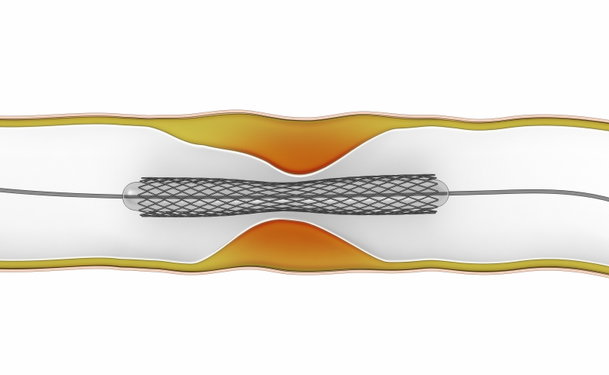Vascular stenting is a treatment for a partially blocked or weak artery or vein. During this minimally-invasive procedure, a small mesh tube (stent) is placed inside a blood vessel to make it stronger and keep it open. The stent stays inside the blood vessel and allows blood to flow through normally.
What are stents?
A stent is a small mesh tube that is placed inside a narrow or weak blood vessel. Stents are usually made of metal, although they can also be made of fabric.
A stent supports the wall of the artery or vein. It keeps the blood vessel open so blood can flow through. Stents also help prevent a weakened artery from bursting as blood flows through.
Some stents placed inside an artery also slowly release a medicine that keeps the artery from becoming blocked again.
What conditions does stenting treat?
Vascular stenting can be used to treat a number of conditions. Most often it is used to treat diseases that affect the arteries, such as coronary heart disease, carotid artery disease or peripheral artery disease.
This procedure can also be used to treat vein diseases like pulmonary vein stenosis and chronic venous insufficiency.
Who is a candidate for stenting?
Stenting is sometimes a viable option for patients who would otherwise need to undergo surgical plaque removal or bypass surgery. Good candidates for stenting include those who have fewer blockages and narrowing vessels, which can be opened using stenting or a combination of stenting and angioplasty, in the absence of additional disease or damage in the heart, heart valves or arteries.
How does stent treatment work?
Vascular stenting is a surgical procedure that is often done along with angioplasty. Angioplasty involves inserting a small balloon into a blood vessel to widen a narrow section.
Before the procedure, you will be given a medicine to help you relax. This will make you sleepy, but you will be awake during the procedure.
Your doctor will numb the area to be treated beforehand with an anesthetic so you don’t feel when the small tube (catheter) is inserted into the blood vessel. However, you may feel some pain when the angioplasty balloon is inflated.
Throughout the procedure, your doctor will use live x-ray pictures to see the blood vessels and the location of the catheters and stent. Your body may also be injected with a special dye to show the flow of blood through your blood vessels.
Your doctor will insert a small needle into one of your blood vessels, such as an artery in your arm, neck or groin. Your doctor will then thread a catheter into the blood vessel until it reaches the weak or narrow section.
The stent is placed over the tip of another catheter that has a balloon on the end. Your doctor will insert this catheter into the blood vessel until it is at the area to be treated.
Once the balloon is in place, it is inflated. This widens the blood vessel and allows blood to flow again. The stent expands as the balloon is inflated. The catheters and balloon are then removed, leaving the stent attached to the inner wall of the blood vessel.
What is recovery after vascular stenting like?
After the procedure, the area where the catheter was inserted will be bandaged. You will remain in a special recovery area for several hours, where you will be asked to move as little as possible.
During recovery, a nurse will check your blood pressure and heart rate regularly. The nurse will also look for signs of bleeding from the site where the catheter was inserted.
Once you are sent home, it can take six to eight weeks to fully recover. You may have soreness in the area where the catheter was inserted. This should go away after a few days.
You may also have swelling in the arm or leg where the catheter was inserted. This should go away after a few days or weeks.
Your doctor may ask you to take aspirin or prescription medications to thin your blood. This reduces the risk of blood clots.
You will need to limit your activity in the beginning. However, you should walk a little each day, gradually increasing the amount.
For the first two or three days, avoid going up and down stairs more than two times a day. You should also avoid strenuous activity for several days.
What are the risks and side effects of vascular stenting?
Stenting is considered a safe, minimally invasive procedure and serious complications are rare. Call your doctor if you experience any of the following symptoms:
- Swelling, pain, redness or yellow or green discharge where the catheter was inserted.
- Bleeding at the catheter site that doesn’t stop when you apply pressure.
- Numbness, coolness or color change in the arm or leg where the catheter was inserted.
- Chest pain or shortness of breath that doesn’t stop when you rest.
- Fainting, dizziness or feeling very tired.
- Coughing up yellow or green mucus, or blood.
- Chills or high fever.
- Weakness in your body, slurred speech or if you can’t get out of bed.


